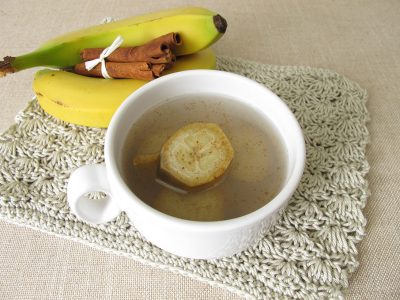
As we all continue on our quests for better sleep, banana peel tea is gaining popularity. Many people have taken to brewing their own banana peel tea in the afternoon or evening as part of their bedtime routine thanks to its supposed relaxation benefits. But what does the research say about banana peel tea for sleep? Find out what this tea can do for your restfulness and other areas of your health.
Note: The content on Sleepopolis is meant to be informative in nature, but it shouldn’t be taken as medical advice, and it shouldn’t take the place of medical advice and supervision from a trained professional. If you feel you may be suffering from any sleep disorder or medical condition, please see your healthcare provider immediately.
Why Does Banana Peel Tea Help With Sleep?
Many people use banana peel tea as a natural sleep-promoting aid. While there’s not a lot of scientific studies behind the benefits of banana peel tea specifically, there is anecdotal support.
Banana peel tea is thought to help support sleep because of certain nutrients and compounds found in bananas. These are predominantly magnesium, potassium, and tryptophan.
Magnesium is a trace mineral that is associated with relaxation, which is why it’s often used as a supplement for calming purposes. Magnesium supports a normal circadian rhythm, which is responsible for your body’s sleep and waking cycles.[1] In fact, having a low intake of magnesium may be associated with shorter sleep patterns.[2] Some research also suggests that magnesium can help reduce levels of the stress hormone cortisol while supporting the production of the sleep hormone melatonin.
Low potassium is often associated with muscle cramps, so it’s often recommended to consume bananas if you’re experiencing them. Getting enough potassium through foods is also important for supporting healthy blood pressure levels, which may further aid sleep.[3]
Finally, tryptophan is an essential amino acid (yep, the one that’s found in turkey). This means the body cannot produce it, so we have to find it in food. Tryptophan-rich foods, like bananas, may help improve sleep quality because it’s converted into the neurotransmitter serotonin in the body.[4] Serotonin is a precursor to melatonin and helps regulate our mood and sleep pattern.[5]
What Does Banana Peel Tea Taste Like, And How Do I Make It?
Banana peel tea is incredibly simple to make. It requires just two ingredients: banana peels and water. The end result? Some people say it tastes similar to black tea. However, the flavor will be slightly sweeter if you use banana peels from ripe bananas versus ones from green bananas.
Making banana tea is a great way to recycle the peels from bananas that you eat instead of just throwing them in the garbage. There are two methods of making banana peel tea at home.
The first method is simply removing fresh peels from bananas, submerging them into a saucepan full of water, and bringing it to a boil. You can also add a bit of the banana to bring more flavor to the tea. Reduce the heat to a simmer, letting the tea brew for 10 minutes. Then, remove the solid pieces and strain the liquid into a mug to enjoy.
The second method requires freezing, drying, and grinding your banana peels. While this is more time-consuming, it can be used to make extra that you can steep later.
Here’s how you do it:
- Remove peels from bananas, including any stickers that are present on the outside. Wash them thoroughly with water and friction, and dry them.
- Place the banana peels in the freezer. It can help to lay them flat in a bag or container so they don’t freeze into one large lump. Collect the peels from three to five bananas to make enough steeping ingredients for multiple uses. Otherwise, one banana peel will generally turn into three tablespoons of dried peel to make one to two cups of tea.
- Once the banana peels are frozen and you’re ready to use them, remove them from the freezer and allow them to thaw on the countertop. Because of their reaction to oxygen, they should start to turn black after an hour or two of sitting out.
- Next, you will dry your banana peels so you can make them into a steeping powder. To do this, place the thawed peels on a cooking sheet and bake in the oven at 150ºF (65ºC) for approximately one hour or until they are dried. Alternatively, you can dry your peels in a dehydrator, laying them flat for 6-8 hours at 155ºF.
- Remove dried peels from the oven or dehydrator and allow them to cool to the touch. Then, gently tear and break them into smaller pieces, dropping them into the bowl of a food processor. From here, you will pulverize them into a large-granule powder.
- When you’re ready to make your tea, pour boiling water over one to three tablespoons of your banana peel powder. Allow the tea to steep until your desired flavor is reached, and then strain the liquid through a fine mesh into a mug.
- Store any leftover dried banana peel powder in a sealed container and in a cool, dark place.
You can add things like cinnamon, ginger, lemon, honey, or milk to banana peel tea just as you would other teas.
When Should I Drink Banana Peel Tea?
The best time to drink banana peel tea is later in the day or the evening rather than in the morning. Its relaxation effects can help promote sleepiness as you get closer to your bedtime routine.
Fresh vs. Dried Banana Peels
There’s not enough evidence to suggest that either fresh or dried banana peels are better for use in banana peel tea. If you want to use up the peels from bananas you consume at home, you can follow the steps above to use fresh peels. If you want to reduce the time it takes to prepare banana peels for tea but don’t want to boil them, consider purchasing dried banana peels.
Other Benefits Of Banana Peel Tea
While robust science is lacking behind banana peel tea specifically, there is some evidence supporting the benefits of bananas for overall wellness, such as the following.
- May support healthy blood pressure. Fruit consumption has been associated with lower blood pressure.[6] Bananas and their peels are a source of potassium, which has been shown to support normal blood pressure levels when consumed via foods versus supplements.[7][8]
- May support healthy digestion. Bananas contain primarily resistant starch, which cannot be digested but acts as a food for probiotics — or good bacteria — in your digestive system. As it passes through, it’s fermented into short-chain fatty acids like butyrate, which benefits intestinal health.[9][10]
- May support feelings of fullness. Bananas are full of fiber, particularly a type of soluble fiber called pectin. Pectin may help keep you satisfied for longer, preventing overeating later.[11][12]
We Tried It — Here’s What We Thought
Cody Gohl, former Sleepopolis staff editor: Well, after giving this tea a go, I noticed a few things. First and foremost, I found it super tasty. It has a pleasant, subtle banana flavor that really worked for me. Secondly, I think it actually did help me to fall asleep! Now I don’t know if it was a placebo or if just drinking something warm before bed is always going to calm you down, but I was definitely in the headspace to snooze.
The Last Word From Sleepopolis
Banana peel tea may sound like an odd beverage, but many people say it helps promote relaxation that benefits their sleep routine. This is likely because bananas, and their peels, are a source of magnesium, potassium, and tryptophan, all of which play a role in calmness and sleep. Plus, it’s really easy to make — all you need is a banana and some hot water!
References
- Abbasi B, Kimiagar M, Sadeghniiat K, Shirazi MM, Hedayati M, Rashidkhani B. The effect of magnesium supplementation on primary insomnia in elderly: A double-blind placebo-controlled clinical trial. J Res Med Sci. 2012;17(12):1161-1169.
- Ikonte CJ, Mun JG, Reider CA, Grant RW, Mitmesser SH. Micronutrient Inadequacy in Short Sleep: Analysis of the NHANES 2005-2016. Nutrients. 2019;11(10):2335. doi:10.3390/nu11102335
- Filippini T, Naska A, Kasdagli MI, et al. Potassium Intake and Blood Pressure: A Dose-Response Meta-Analysis of Randomized Controlled Trials. J Am Heart Assoc. 2020;9(12):e015719. doi:10.1161/JAHA.119.015719
- Binks H, E Vincent G, Gupta C, Irwin C, Khalesi S. Effects of Diet on Sleep: A Narrative Review. Nutrients. 2020;12(4):936. doi:10.3390/nu12040936
- Pereira N, Naufel MF, Ribeiro EB, Tufik S, Hachul H. Influence of Dietary Sources of Melatonin on Sleep Quality: A Review. J Food Sci. 2020;85(1):5-13. doi:10.1111/1750-3841.14952
- Elsahoryi NA, Neville CE, Patterson CC, et al. Association between overall fruit and vegetable intake, and fruit and vegetable sub-types and blood pressure: the PRIME study (Prospective Epidemiological Study of Myocardial Infarction). Br J Nutr. 2021;125(5):557-567. doi:10.1017/S0007114520001518
- Giri SS, Jun JW, Sukumaran V, Park SC. Dietary Administration of Banana (Musa acuminata) Peel Flour Affects the Growth, Antioxidant Status, Cytokine Responses, and Disease Susceptibility of Rohu, Labeo rohita. J Immunol Res. 2016;2016:4086591. doi:10.1155/2016/4086591
- Filippini T, Naska A, Kasdagli MI, et al. Potassium Intake and Blood Pressure: A Dose-Response Meta-Analysis of Randomized Controlled Trials. J Am Heart Assoc. 2020;9(12):e015719. doi:10.1161/JAHA.119.015719
- Keenan MJ, Zhou J, Hegsted M, et al. Role of resistant starch in improving gut health, adiposity, and insulin resistance. Adv Nutr. 2015;6(2):198-205. doi:10.3945/an.114.007419
- Liu H, Wang J, He T, et al. Butyrate: A Double-Edged Sword for Health?. Adv Nutr. 2018;9(1):21-29. doi:10.1093/advances/nmx009
- Salleh SN, Fairus AAH, Zahary MN, Bhaskar Raj N, Mhd Jalil AM. Unravelling the Effects of Soluble Dietary Fibre Supplementation on Energy Intake and Perceived Satiety in Healthy Adults: Evidence from Systematic Review and Meta-Analysis of Randomised-Controlled Trials. Foods. 2019;8(1):15. doi:10.3390/foods8010015
- Wanders AJ, Feskens EJ, Jonathan MC, Schols HA, de Graaf C, Mars M. Pectin is not pectin: a randomized trial on the effect of different physicochemical properties of dietary fiber on appetite and energy intake. Physiol Behav. 2014;128:212-219. doi:10.1016/j.physbeh.2014.02.007




























